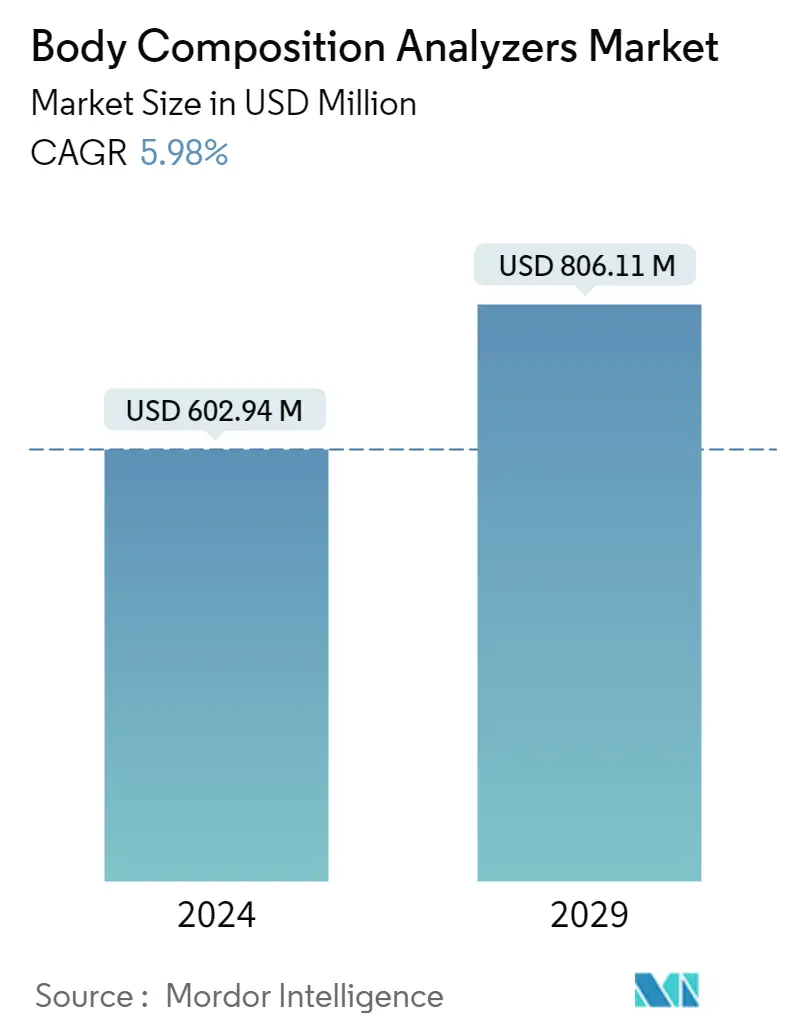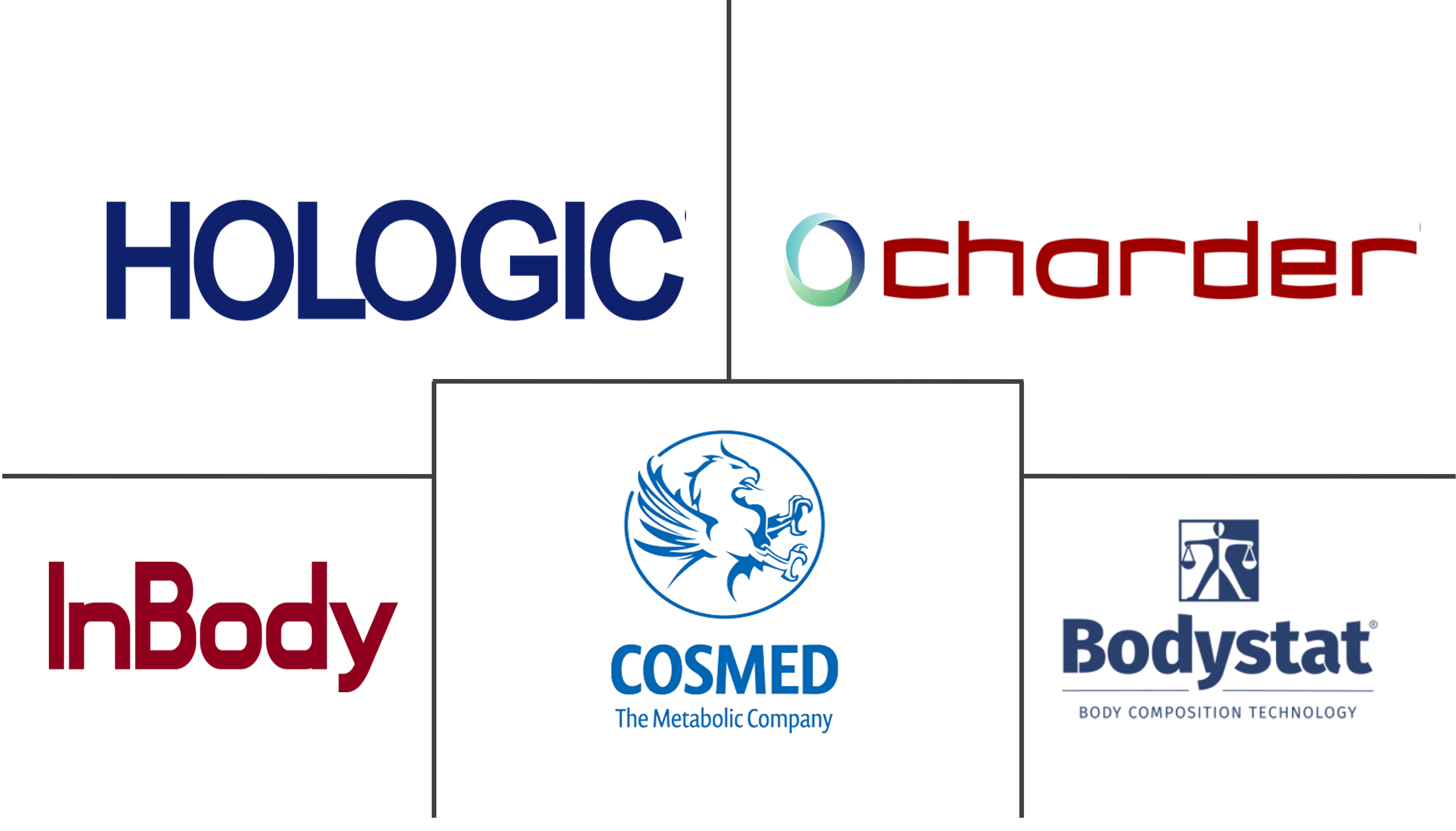Market Size of Body Composition Analyzers Industry

| Study Period | 2019 - 2029 |
| Market Size (2024) | USD 602.94 Million |
| Market Size (2029) | USD 806.11 Million |
| CAGR (2024 - 2029) | 5.98 % |
| Fastest Growing Market | Asia Pacific |
| Largest Market | North America |
Major Players
*Disclaimer: Major Players sorted in no particular order |
Body Composition Analyzers Market Analysis
The Body Composition Analyzers Market size is estimated at USD 602.94 million in 2024, and is expected to reach USD 806.11 million by 2029, growing at a CAGR of 5.98% during the forecast period (2024-2029).
The COVID-19 pandemic has impacted the body composition analyzers market owing to the high prevalence of obesity as a result of poor eating habits during the pandemic. Also, various studies indicated that COVID-19 adversely impacted people with obesity. For instance, in an article published in September 2021, studies in New York City demonstrated that after advanced age, obesity was the most common risk factor leading to severe illness and death from COVID-19. Post-pandemic, there is a high awareness regarding the importance of prioritizing personal health.
This has also led to partnerships and launches by market players to boost the utilization of body composition analyzers. For instance, in January 2022, Orangetheory Fitness partnered with InBody to offer more precise body composition tracking. Through this collaboration, Orangetheory Fitness members could take a 15-second InBody Test, a research-backed body composition analysis, at more than 1,400 participating studio locations to get an accurate and reliable breakdown of their body composition. Hence, the studied market is expected to register a stable growth rate during the forecast period.
The major drivers for the studied market are the large pool of obese patients and the increasing prevalence of metabolic disorders, technological advancements, and rising awareness for health and fitness.
The rising prevalence of obesity and metabolic disorders worldwide is expected to boost the demand for body composition analyzers to track their health progress. For instance, as per the World Obesity Atlas 2022 report, an estimated one billion people globally, including 1 in 5 women and 1 in 7 men, are predicted to live with obesity by 2030. Also, according to the Global Obesity Observatory data updated in 2022, the prevalence of obesity in adults aged 18 and above was 38.1% in Iran, 35% in Ireland, 32.5% in Italy, and 36.4% in Scotland in 2021. Therefore, the high burden of obesity is expected to boost the market growth during the forecast period.
Furthermore, the strategies adopted by government bodies for creating awareness of health and fitness also contribute to market growth. For instance, in March 2022, the National Obesity Strategy was launched in Australia, a 10-year framework (2022-2032) for action to prevent, educate, reduce, and treat overweight and obesity in the country. It emphasizes prevention and includes steps to help Australians who are overweight or obese live their healthiest lives. Such initiatives are expected to boost the utility of body composition analyzers for measuring obesity and fitness.
Therefore, owing to the aforementioned factors, such as the high burden of obesity and rising government initiatives for awareness and obesity control, which is expected to boost the demand for body composition analyzing devices, the studied market is anticipated to witness growth over the analysis period. However, the high equipment costs and inconsistency and inaccuracy in different analyzers are expected to restrain the market growth.
Body Composition Analyzers Industry Segmentation
As per the scope of the report, the devices used for measuring diverse compounds present in the body and delivering their respective values at the examination point are body composition analyzers (BCA). Body composition analyzers have many applications in sports and medical research, especially causal association research studies in anthropology, nutrition, epidemiology, etc.
The body composition analyzers market is segmented by product (bio-impedance analyzer, skinfold calipers, hydrostatic weighing equipment, air displacement plethysmography, dual-energy x-ray absorptiometry, and other products), end user (hospitals, fitness clubs, and wellness centers, academic and research centers, and other end users), and geography (North America, Europe, Asia-Pacific, Middle East and Africa, and South America). The market report also covers the estimated market sizes and trends for 17 countries across major global regions. The report offers the value (in USD) for the above segments.
| By Product | |
| Bio-impedance Analyzer | |
| Skinfold Calipers | |
| Hydrostatic Weighing Equipment | |
| Air Displacement Plethysmography | |
| Dual Energy X-ray Absorptiometry | |
| Other Products |
| By End User | |
| Hospitals | |
| Fitness Clubs and Wellness Centers | |
| Academic and Research Centers | |
| Other End Users |
| Geography | ||||||||
| ||||||||
| ||||||||
| ||||||||
| ||||||||
|
Body Composition Analyzers Market Size Summary
The body composition analyzers market is poised for significant growth, driven by increasing awareness of personal health and fitness, particularly in the wake of the COVID-19 pandemic, which highlighted the risks associated with obesity. The market is characterized by technological advancements and strategic partnerships, such as the collaboration between Orangetheory Fitness and InBody, which aim to enhance the accuracy and accessibility of body composition tracking. The rising prevalence of obesity and metabolic disorders globally is a major driver, as these conditions necessitate effective monitoring and management solutions. Government initiatives, like Australia's National Obesity Strategy, further bolster market demand by promoting health awareness and obesity prevention. Despite challenges such as high equipment costs and variability in analyzer accuracy, the market is expected to experience stable growth.
The bio-impedance analyzer segment is anticipated to expand due to the growing adoption of wearable devices and ongoing research leading to innovative product developments. Notable advancements include the introduction of wristwatch-type bioelectrical impedance analyzers and the integration of such technology in consumer electronics, like Samsung's Galaxy Watch. The North American region is expected to maintain a significant market share, supported by the high prevalence of obesity, technological innovations, and active market players. The competitive landscape is marked by the presence of key companies such as Bodystat, InBody Co. Ltd., and Hologic Inc., which are driving product innovation and market expansion through strategic initiatives.
Body Composition Analyzers Market Size - Table of Contents
-
1. MARKET DYNAMICS
-
1.1 Market Overview
-
1.2 Market Drivers
-
1.2.1 Large Pool of Obese Patients and Increasing Prevalence of Metabolic Disorders
-
1.2.2 Technological Advancements
-
1.2.3 Rising Awareness for Health and Fitness
-
-
1.3 Market Restraints
-
1.3.1 High Equipment Costs
-
1.3.2 Inconsistency and Inaccuracy in Different Analyzers
-
-
1.4 Porter's Five Forces Analysis
-
1.4.1 Threat of New Entrants
-
1.4.2 Bargaining Power of Buyers/Consumers
-
1.4.3 Bargaining Power of Suppliers
-
1.4.4 Threat of Substitute Products
-
1.4.5 Intensity of Competitive Rivalry
-
-
-
2. MARKET SEGMENTATION (Market Size by Value - USD million)
-
2.1 By Product
-
2.1.1 Bio-impedance Analyzer
-
2.1.2 Skinfold Calipers
-
2.1.3 Hydrostatic Weighing Equipment
-
2.1.4 Air Displacement Plethysmography
-
2.1.5 Dual Energy X-ray Absorptiometry
-
2.1.6 Other Products
-
-
2.2 By End User
-
2.2.1 Hospitals
-
2.2.2 Fitness Clubs and Wellness Centers
-
2.2.3 Academic and Research Centers
-
2.2.4 Other End Users
-
-
2.3 Geography
-
2.3.1 North America
-
2.3.1.1 United States
-
2.3.1.2 Canada
-
2.3.1.3 Mexico
-
-
2.3.2 Europe
-
2.3.2.1 Germany
-
2.3.2.2 United Kingdom
-
2.3.2.3 France
-
2.3.2.4 Italy
-
2.3.2.5 Spain
-
2.3.2.6 Rest of Europe
-
-
2.3.3 Asia-Pacific
-
2.3.3.1 China
-
2.3.3.2 Japan
-
2.3.3.3 India
-
2.3.3.4 Australia
-
2.3.3.5 South Korea
-
2.3.3.6 Rest of Asia-Pacific
-
-
2.3.4 Middle East and Africa
-
2.3.4.1 GCC
-
2.3.4.2 South Africa
-
2.3.4.3 Rest of Middle East and Africa
-
-
2.3.5 South America
-
2.3.5.1 Brazil
-
2.3.5.2 Argentina
-
2.3.5.3 Rest of South America
-
-
-
Body Composition Analyzers Market Size FAQs
How big is the Body Composition Analyzers Market?
The Body Composition Analyzers Market size is expected to reach USD 602.94 million in 2024 and grow at a CAGR of 5.98% to reach USD 806.11 million by 2029.
What is the current Body Composition Analyzers Market size?
In 2024, the Body Composition Analyzers Market size is expected to reach USD 602.94 million.

